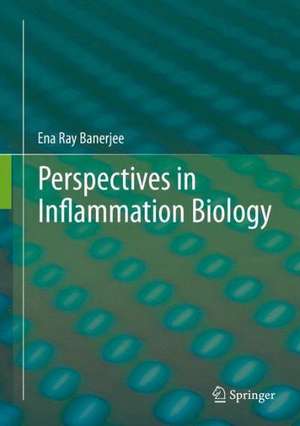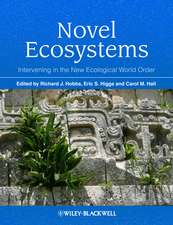Perspectives in Inflammation Biology
Autor Ena Ray Banerjeeen Limba Engleză Hardback – 23 oct 2013
| Toate formatele și edițiile | Preț | Express |
|---|---|---|
| Paperback (1) | 940.39 lei 6-8 săpt. | |
| Springer India – 23 aug 2016 | 940.39 lei 6-8 săpt. | |
| Hardback (1) | 948.29 lei 6-8 săpt. | |
| Springer India – 23 oct 2013 | 948.29 lei 6-8 săpt. |
Preț: 948.29 lei
Preț vechi: 1156.45 lei
-18% Nou
Puncte Express: 1422
Preț estimativ în valută:
181.46€ • 189.93$ • 151.03£
181.46€ • 189.93$ • 151.03£
Carte tipărită la comandă
Livrare economică 31 martie-14 aprilie
Preluare comenzi: 021 569.72.76
Specificații
ISBN-13: 9788132215776
ISBN-10: 813221577X
Pagini: 160
Ilustrații: XVI, 148 p. 66 illus., 15 illus. in color.
Dimensiuni: 178 x 254 x 17 mm
Greutate: 0.53 kg
Ediția:2014
Editura: Springer India
Colecția Springer
Locul publicării:New Delhi, India
ISBN-10: 813221577X
Pagini: 160
Ilustrații: XVI, 148 p. 66 illus., 15 illus. in color.
Dimensiuni: 178 x 254 x 17 mm
Greutate: 0.53 kg
Ediția:2014
Editura: Springer India
Colecția Springer
Locul publicării:New Delhi, India
Public țintă
ResearchCuprins
Chapter 1. Pulmonary and Systemic inflammation.- Chapter 2. Preclinical models of acute and chronic models of lung inflammation.- Chapter 3. Studying the roles of some key molecules in acute allergic asthma.- Research area 1- Enantiomers of albuterol, the OTC drug of choice for acute asthma management.- Research area 2. Studies on prophylactic and therapeutic strategies to combat some local and systemic inflammatory pathologies .- Sub-chapter I. Role of integrin α4 (VLA- Very Late Antigen 4) and integrin β2 (CD18) in a pulmonary inflammatory and a systemic disease model using genetic knockout mice.- Sub-chapter 2. Role of E-, L-, and P-selectins in the onset, maintenance and development of acute allergic asthma.- Sub-Chapter 3. Role of gp91phox subunit of NADPH oxidase and MMP-12 in a acute inflammatory and an acute degenerative pulmonary disease model using genetic knockout mice.- Chapter 4. Role of integrins α4 and β2 onset and development of chronic allergic asthma in mice.- Chapter 5 Role of integrin α4 (VLA- Very Late Antigen 4) in lymphopoiesis by short and long term transplantation studies in genetic knockout model of mice.- Chapter 6. Studying the roles of some critical molecules in systemic inflammation.
Notă biografică
Dr. Ena Ray Banerjee is Associate Professor of Zoology in University of Calcutta, India and an alumnus of the premiere educational institutions Lady Brabourne College and Gokhale Memorial Girls’ school. She was trained in Immunobiology during her PhD and worked extensively in immune modulation in inflammation in general and cytokine mediated inflammation in particular. Having taught both under- and post-graduate Zoology as lecturer under University of Calcutta, India, for several years, she pursued her post-doctoral studies as visiting scientist and subsequently faculty of University of Washington, School of Medicine, Seattle, USA. There she began with immunological studies defining key molecules in inflammation and eventually super-specialized into lung inflammation particularly allergy and made a natural transition onto regenerative medicine of the lung, having worked with one of the foremost scientists in stem cell biology, Professor Thalia Papayannopoulou and a renowned allergist Dr. William R. Henderson, Jr. Her work pioneered tissue engineering of lung lineage specific cells of the non-ciliated variety from human embryonic stem cells and identified stem cell niches in mouse lung. She returned to India and worked for a while in a drug discovery company Advinus Therapeutics, a TATA enterprise, where she led in vitro and in vivo efforts in pharmacological molecules, drug discovery in asthma and related respiratory illness, and then returned to academics as Reader in her alma mater, the renowned University of Calcutta.
Textul de pe ultima copertă
“Perspectives in Inflammation Biology” outlines detailed studies using preclinical murine models in Inflammation. The book is meant for academicians, industry persons, research scholars and students alike. The detailed perspective for a beginner and the exhaustive methodologies and analyses outlined, for the veteran researcher, makes this book a unique link between someone who is thinking of embarking on a study of inflammation and one who is delving deep into this area of specialization. The book deals with asthma and allergy as specific disease areas of inflammation of the lung, aseptic peritonitis as a disease of systemic inflammation and details how each role player in its pathophysiology has a unique niche of activity. Data acquisition, sequentiality and analyses in context demonstrate how each role player is validated systematically to become a target for drug discovery. Methods and models used in the course of my work and their relevance will demonstrate to the researcher how astudy can be developed from an idea. Further into a researcher’s ongoing work, this book is meant to stimulate new questions and pave ways for better dissection of a phenomenon. The highlights of this book are the detailed tables tabulating sub species of immune cells, their inflammatory recruitment indices, their translation into tissue-to-tissue traffic of the inflammatory stimulus and the delicate interplay of resident structural cells, cells recruited from circulation, their feedback poiesis in bone marrow, their instruction in the lymphoid organs and tissues as well as the non-cellular mediators synthesized from corresponding genetic instruction. The book shall definitely help students and researchers how a disease can be simplified from its complex ramifications and network of implications and put back into perspective and the whole thing falls into place without an intimate understanding of the mechanism and the compelling circumstances that causes a disease, a drug hunter cannot hope to begin her quest. To find the “Achilles’ heel” and effectively neutralize the enemy!












